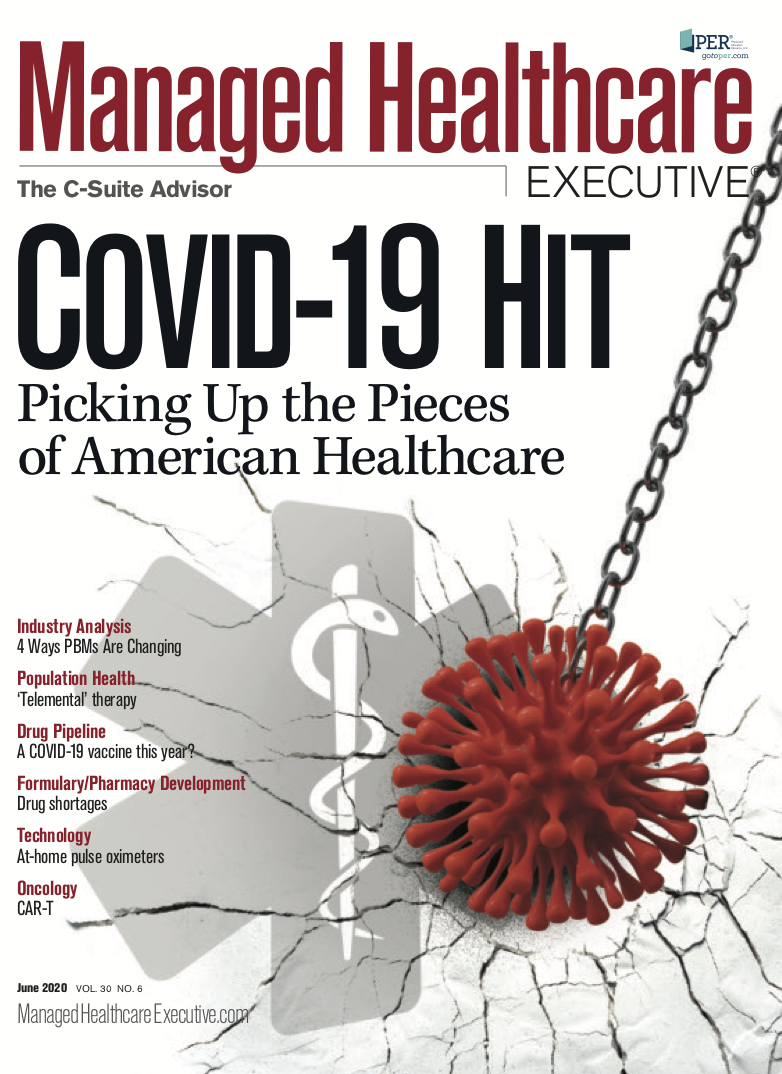4 Ways PBMs are Changing
Pharmacy benefit managers are taking steps to be more responsible for the total cost of care and to become more transparent, while adding technology tools to support patients, payers and physicians in a post-COVID-19 world.

Pharmacy benefit managers (PBMs) argue that they play a vital role in the labyrinth of U.S. healthcare as pharmaceutical company intermediaries, serving purchasers (such as employers) and payers (such as Medicare and commercial health insurers). Critics, however, contend that PBMs serve the needs of pharmaceutical companies at the expense of purchasers, payers and, ultimately, patients.
Over the past two-plus years, PBMs have begun pushing back against this criticism, in part, by expanding their efforts and going beyond managing
pharmaceutical costs - de-emphasizing rebates and streamlining formularies - to accepting more responsibility for managing the total cost of health- care for their insurer and employer clients. The larger PBMs have also strengthened their market positions through mergers and acquisitions. PBMs have also improved their data analytics.
Here are four ways that the PBM industry is changing:
1. Supporting physicians and providers at the point of care
One of the most pressing problems PBMs face today is how to help physicians and other prescribers while face-to-face visits with patients are limited during the COVID-19 pandemic. Even though in-person visits are limited, doctors and other providers still need to prescribe, monitor and/or change medications, says David Calabrese, RPh, M.H.P., senior vice president and chief pharmacy officer at OptumRx and a member of the Managed Healthcare Executive® editorial advisory board. To address this challenge, OptumRx is supporting telemedicine visits between physicians and patients by having pharmacists participate in some visits. Calabrese says the company is also making digital engagement tools available to physicians and other providers. “We have tools to deliver information about patient adherence to improve cost efficiency and drive quality at the point of care,” he says. “In our specialty pharmacies, for example, we use a video chat-type format to engage patients, educate them and empower them to take a more active role in their care.”
Prime Therapeutics, a PBM in the suburban Twin Cities serving 23 Blue Cross Blue Shield Plans, also recognizes the increased need for virtual care and, additionally, has put more emphasis on infectious disease prevention for every patient, says Kelly McGrail-Pokuta, Prime’s vice president of pharmacy trade relations. “The COVID-19 pandemic has certainly altered every part of the healthcare system in the past couple months,” she comments. “No one knows exactly what the future will hold, but PBMs are working with all parts of the supply chain and with payers and providers to make the changes needed quickly and thoughtfully. All parties are aligned in helping to drive the best care in a consumer-focused manner at the most affordable price.”
2. Assuming more responsibility for the total cost of care
Historically, the function of PBMs has been to manage the cost of prescription medications. Now, however, PBMs are “going beyond the pill” and assuming a larger role in managing the total cost of care. Last year Express Scripts signed a contract with eight of the 16 member-employers of the National Drug Purchasing Coalition to, among other things, hire care managers to improve medication adherence.
OptumRx aims to lower the total cost of care by working closely with patients who have chronic and costly conditions, such as diabetes. “Not only do we use pharmacists, but we also use certified diabetes educators, nurses and nutritionists across our Optum Enterprise to better care for patients with diabetes. Monitoring adherence is one of the main arrows in the PBM quiver. “We do that as one of the many components of our solution suite to manage the total cost of care. That’s where we’re focusing our efforts.”
Prime Therapeutics is doing similar work under value-based care contracts in which payers and employers pay more for medications when pharmaceutical companies can show that their drugs are working as intended and helping to drive down the total cost of care, McGrail-Pokuta says. On the flip side, payers and employers pay less for medications that do not work
as intended.
“Pharma is becoming more comfortable with value-based care agreements, which means they’re collaborating with PBMs on how quality outcomes are defined for certain medications,” McGrail-
Pokuta notes. “Those agreements will continue to grow in number because validating drug performance using real-world evidence is a priority for most pharma companies and because payers want to ensure the treatments that they pay for actually work.”
In addition, Prime Therapeutics is going outside the traditional PBM lane of managing the drug benefit only by taking on the medical benefit. “For some categories, such as specialty drugs, managing across benefits provides a more holistic view of total plan spending,” she says. “We also offer reinsurance for some specialty drugs and apply predictive analytics to control spending for high-cost utilizers.”
To the criticism that PBMs are greedy middlemen, McGrail-Pokuta offers this counterview: “Prime and other PBMs serve as a counterbalance against rising drug prices and are a part of the system that help control overall healthcare costs,” she says. “Without them, drug prices would go unchecked.”
3 Providing increased cost control and transparency in pharmacy benefit design
Utilization review, prior authorization, formulary tiers - familiar tools in the managed care toolkit. Today, PBMs are supplementing these tools with copay accumulators, point-of-service rebates and formularies that exclude high-cost or low-value medications. “These approaches can increase market share in preferred products and help save the member and payer on drug costs,” McGrail-Pokuta explains. Prime Therapeutics also uses assessments from the Institute for Clinical and Economic Review (ICER), an independent drug pricing and value organization in Boston. “ICER’s analyses help to shape our outcomes-based contracts and coverage determinations,” she notes.
In an effort to eliminate wasteful, low-value medications, OptumRx announced a new formulary this year.
“We’ve heard clearly from the client community that they want more aggressiveness in formulary design to eliminate waste in formularies and improve affordability,” Calabrese explains. “Our Premium Value Formulary is designed to address those concerns” and eliminate access to products that don’t deliver value. The new formulary excludes select high-cost, brand-name medications that have high rebates from pharmaceutical companies and instead includes lower-cost, generic alternatives Calabrese says that OptumRx’s new formulary is designed to address those concerns and “eliminate access to products that don’t deliver value.”
The new formulary excludes high-cost brand-name medications that have high rebates from pharmaceutical companies and instead includes lower-cost generic alternatives that offer the same clinical outcomes. Some of the brand-name drugs excluded from OptumRx’s new Premium Value formulary because far less-expensive generic alternatives are available include Vyvanse (lisdexamfetamine), Clindagel (clindamycin gel) and Edarbi (azilsartan medoxomil). Calabrese says the new formulary allows OptumRx to move away from the traditional rebate model. “Instead,” he says, “we will contract with clients in a more performance-driven model where we are paid based on our ability to manage the cost and quality of pharmacy care.”
4 Responding to criticism about PBM contracting strategies
Like other PBMs, OptumRx and Prime Therapeutics have modified their business strategies in response to demands from payers and purchasers, particularly following criticism of PBM practices last year from Congress and some state legislatures.
OptumRx, for example, has sought to transform its operations. “We’ve moved away from a traditional business-focused type of model into what we like to refer to as more of a pharmacy-care services model,” Calabrese notes. “We do that by focusing on making medications more affordable for payers, purchasers and patients. In specialty drug management, in particular, we’re moving away from just managing the cost of drugs to managing the total cost of care.”
Prime Therapeutics also is going beyond the financial management of medications, says McGrail-Pokuta. “PBMs, including Prime, provide an important service in evaluating the clinical appropriateness of therapies to ensure members are receiving the appropriate drug in the right clinical setting,” she explains, noting that Prime and other PBMs have a hand in managing many aspects of prescribing, medication use and adherence. “
Rebates from drug companies are controversial because they may lead to formularies with low-value, high-cost medications.
“Prime’s model is to pass all rebate dollars back to our client health plans so they can use those savings to help keep healthcare costs affordable for their members,” McGrail-Pokuta says. “Then they can use those funds to lower premiums (or) copays or to offer point-of-sale rebates.”
Joseph Burns is an independent journalist in Massachusetts who writes about healthcare.

David Calabrese of OptumRx Talks New Role, Market Insulin Prices and Other Topics 'On His Mind'
April 13th 2023In this month’s episode of the "What's On Your Mind podcast," Peter Wehrwein, managing editor of MHE connects with the now Chief Clinical Officer of OptumRx Integrated Pharmacies, David Calabrese. In this conversation, David touches on his transition in January as OptumRx’s former chief pharmacy officer and market president of health plans and PBMs to his new role as Chief Clinical Officer where he now focuses more on things such as specialty pharmacy to home delivery — with an overall goal of creating whole-patient care. Throughout the conversation, Calabrese also touched on the market’s hot topic of insulin prices and behavioral health services within the OptumRx community, among other topics.
Listen
Briana Contreras, editor of Managed Healthcare Executive, spoke with Nancy Lurker, CEO and president of EyePoint Pharmaceuticals. Nancy shared a bit about EyePoint and how the organization’s innovative therapies are addressing patient needs through eye care, and most importantly, she addressed C-Suite positions like the CEO role. Nancy shared advice for those seeking to reach the CEO level, especially toward women in healthcare and other roles, and what it takes to run a biopharma company.
Listen
Upended: Can PBM Transparency Succeed?
March 6th 2024Simmering tensions in the pharmacy benefit management (PBM) industry have turned into fault lines. The PBMs challenging the "big three" have formed a trade association. Purchaser coalitions want change. The head of the industry's trade group says inherent marketplace friction has spilled over into political friction.
Read More
Florida Gets the OK. But Will Drug Importation from Canada Actually Happen?
March 5th 2024Canadian health officials warn that maintaining a drug supply for Canadians is their priority. The staunch opposition of the U.S. pharmaceutical industry may also be an obstacle to imports from north of the border.
Read More